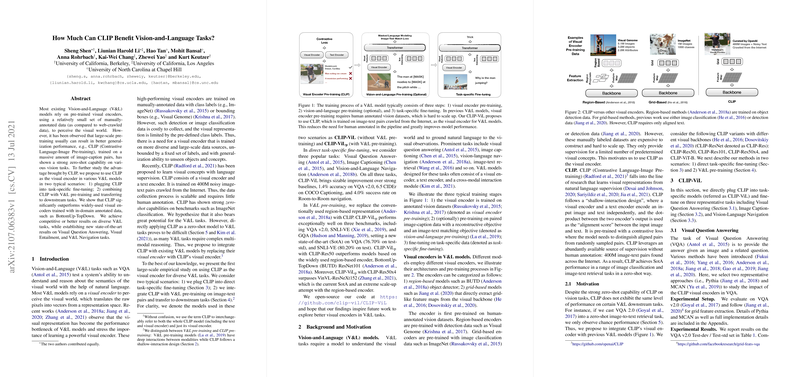An Analysis of "How Much Can CLIP Benefit Vision-and-Language Tasks?"
The paper "How Much Can CLIP Benefit Vision-and-Language Tasks?" offers a comprehensive examination of the performance of CLIP (Contrastive Language–Image Pretraining) across various vision-and-language benchmarks. This work reflects a rigorous exploration into the capabilities of CLIP, providing valuable insights for researchers focused on multimodal tasks.
Methodology and Experimental Design
The authors employ a structured approach, leveraging CLIP's unified vision-language representation power to assess its effectiveness in common tasks such as Visual Question Answering (VQA), Image Captioning, and Visual Grounding. The evaluation involves adapting pre-trained CLIP models without extensive task-specific finetuning, thus demonstrating a significant strength of CLIP in zero-shot or minimal training scenarios.
A notable aspect of the methodology is the comparative analysis between CLIP-based models and existing state-of-the-art (SOTA) methods. By establishing clear performance metrics, the paper underscores the advantages and potential limitations of CLIP's architecture when applied to heterogeneous datasets and varying task formats.
Numerical Results and Performance Evaluation
The paper presents quantitative results that underscore CLIP's competitive performance. Particularly in zero-shot scenarios, CLIP demonstrates robust capabilities, rivaling — and in certain instances surpassing — task-specific systems that rely on extensive finetuning. Such results emphasize the versatility of CLIP in handling diverse vision and language integration tasks.
For tasks like VQA and Image Captioning, CLIP's performance is characterized by its high adaptability, maintaining accuracy within marginal ranges of specialized architectures. Nonetheless, in other specific tasks, existing SOTA models maintain a lead, indicating areas for further enhancement and adaptation in CLIP's framework.
Discussion and Implications
The findings contribute significant theoretical value to the paper of vision-and-language learning paradigms. They prompt a reevaluation of traditional task-specific approach dependencies, indicating potential shifts towards broader multimodal pre-trained models in future AI system designs.
Practically, the paper advocates for the incorporation of CLIP as a foundational model in real-world applications, particularly where flexibility and minimal-data scenarios are advantageous. The adaptability of CLIP could lead to more efficient deployment strategies across industries, ranging from automated content moderation to assistive technologies that rely on interpretative visual understanding.
Future Directions
The research opens several avenues for future investigation. Key among them is the exploration of hybrid models that could integrate CLIP's generalization strengths with task-specific enhancements, thus bridging existing performance gaps observed in certain benchmarks.
Additionally, there is scope for advancing algorithms that enhance CLIP's ability to learn from fewer examples, pushing the boundaries of current few-shot learning paradigms. Investigating methods to integrate more nuanced contextual understanding and domain-specific knowledge remains a promising direction for subsequent research.
Conclusion
In summary, the paper provides a nuanced and robust analysis of CLIP's potentials and limitations, supporting its aim of understanding how such models can benefit vision-and-language tasks. The implications are far-reaching, suggesting shifts in AI research and application strategies towards more generalized yet adaptable multimodal frameworks. The paper stands as a critical reference point for ongoing research in the domain of integrated AI systems.
